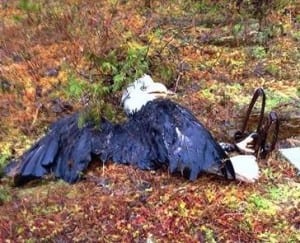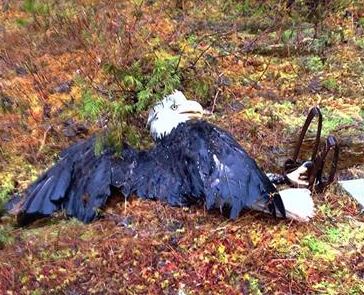
This eagle was found stuck in a trap along Cabin Creek road. The bird was released with the help from ADF&G. Photo courtesy of Jordan Wiener
Most people don’t want to see an eagle stuck in a trap. But that’s what Jordan Wiener witnessed when he was out walking a dog with his girlfriend last month.
They were walking on a popular road just outside of Petersburg which leads to a reservoir. His girlfriend, Janna Machalek, noticed something moving in the bushes about 15 to 20 feet off the road.
“When she got a second look at it was an eagle and when it tried to fly away it had a rusty old trap hooked around its leg and it couldn’t get off,” Wiener said.
The couple tried to free the eagle but couldn’t. Wiener drove back closer to town where he had cell phone service and soon a few people from the local fish and game office were on the scene. They put a coat over the bird to calm it and together the four of them set the bird free.
“We got a set of vice grips and some channel locks and popped the trap open and it just kind of hopped off to go dry off somewhere,” Wiener said. “It looked like it had been there at least for a couple of hours in the rain. We couldn’t really tell how long it had been there.”
Luckily, the bird’s leg wasn’t broken.
Borough laws prohibit trappers from setting near populated areas of Petersburg. But out of town there are no laws against it, not federal nor state.
“There are no regulations which specify setbacks from trails or setbacks from roads,” said Rich Lowell, Area Wildlife Biologist for the Fish and Game office in Petersburg. “In the case of the state, those regulations would be implemented by the Alaska Board of Game. We have not had any proposals during my tenure here which is 15 years to establish any kind of setbacks from recreational trails or campgrounds or popular public areas.”
Until new laws are put into place it boils down to personal decision making.
Some trappers, like Brent Akers of Petersburg, put up warning signs. He’s been trapping for over 35 years, targeting marten and wolves in Duncan Canal on Kupreanof Island.
“There are three cabins in one of my areas and I notify those owners when I’m going to be setting wolf traps in that area,” Akers said. “I try to keep them a good ways away from the cabins.”
He posts a sign at the Tonka Dock warning others of the predator traps he has along the roadway there. Akers also doesn’t trap during duck season, even though he legally could, because of the increased traffic in the area.
He said trapping involves common sense and ethics. He believes trappers should not be setting anywhere near well used trails. But he said dog owners also must be responsible.
“And also people with their dogs have to use a little common sense during the trapping season,” Akers said. “If you’re out and about you should keep your dogs close by.”
The trapping season in the Petersburg area runs November 1-April 30.
In a video produced by the Alaska Trappers Association, trapper Pete Buist explains that it’s not in anyone’s best interest to trap pets.
“A trap with a dog in it obviously is not going to catch a valuable fur bearer,” Buist said. “The set area cannot be readily reused. The trap must be cleaned and treated before it can be reused again.”
The half-hour video is posted on the Alaska Department of Fish and Game website. It demonstrates how to release a dog from various traps. It also gives other tips to non-trappers.
Petersburg resident, Lindsi Dreisbach, was able to steer clear of trouble when she was out walking with her dog and kids.
“We weren’t very far into the trail before we saw just these paper signs that had been laminated, pinned to trees that said, ‘warning, wolf snares ahead’ and we just turned around and left,” she said.
Another time her family wasn’t so lucky. Her husband had their two Labs with him while he was cutting wood near Three Lakes Road. He heard his 11-month old puppy crying in the woods and went to find him.
“He found him off the road a little bit in a wolf snare and as he was going to get him my husband steps in a wolf snare and traps himself,” Dreisbach said. “So, he has to take it off his leg and then get to our dog who is still doing okay.”
The dog had to go to the vet for a bulging eye caused by ruptured blood vessels. It’s been a few weeks now and he’s fully recovered. Dreisbach doesn’t blame the trapper.
“It was purely our fault, everything was marked and labeled as it should have been,” she said. “It was just a case of losing track of our dog.”
There are tagging laws requiring some kind of identification to be with the trap, whether it’s the trapper’s name or some kind of associated number. The trap that caught the eagle wasn’t labeled, which is illegal. Wiener said the trap was out in the open, not hidden in the brush.
“The only thing we saw that could signify a trap being nearby is somebody had tied some branches in a circle on some nearby willows,” he said. “So, we assumed that was his mark for himself but we had no idea.”
The trapping issue won’t be going away anytime soon. A house bill has been introduced by Anchorage Democrat, Andy Josephson, which seeks to prohibit trapping within 200 feet of public trails and facilities.
This is the first of a two part series on trapping near Petersburg. You can find tips on how to get your dog out of a trap or snare in ADF&G’s new brochure here.












